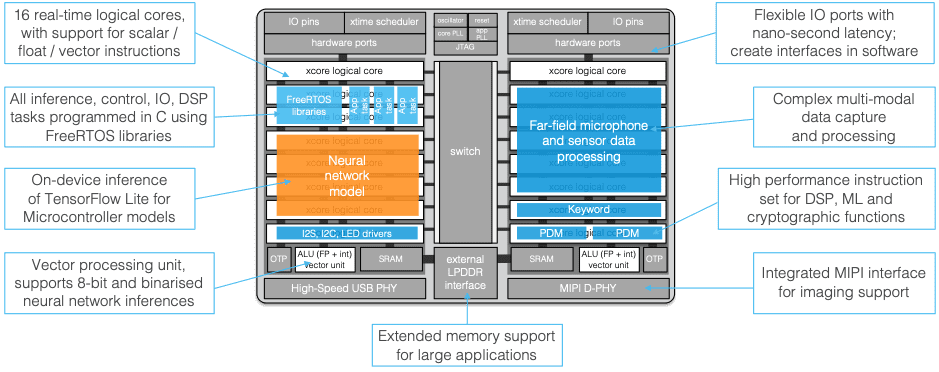From the company that brought out the highest performing voice interface for under a dollar, comes xcore®.ai — the fast, flexible and economical processor, designed for the AIoT
Bristol UK, 13th February 2020 — Tech company XMOS today announces xcore.ai — its new, disruptive crossover processor for the AIoT market, which delivers high-performance AI, DSP, control and IO in a single device with prices from $1.
Traditionally this type of capability would be deployed either through a powerful (and costly) applications processor or a microcontroller with additional components to accelerate key capabilities. However, the new xcore.ai crossover processor from XMOS is architected to deliver real-time inferencing and decisioning at the edge, as well as signal processing, control and communications, enabling electronics manufacturers to integrate high-performance processing and intelligence economically into their products.
Today’s smart devices typically require energy-hungry and costly connectivity to the cloud. This comes marred with challenges around latency, connectivity, privacy and energy consumption. By providing efficient, high-performance compute at the edge, xcore.ai delivers solutions to each of these challenges while keeping cost low and design potential high.
xcore.ai heralds an entirely new generation of embedded platform. It’s the most versatile, scalable, cost-effective and easy-to-use processor on the market today. With its fast processing and neural network capabilities, xcore.ai enables data to be processed locally and actions taken on device —within nanoseconds. In the rapidly evolving AIoT ecosystem, this enables manufacturers to build smarter sensing technology that fits seamlessly into our lives.
But what does this all mean in reality and can xcore.ai help to change the user experience for the better?
Imagine the humble smoke detector — a device designed to ensure our safety. They’ve come a long way since the first alarm was patented in 1890, but do they do enough? Yes, they alert us to danger and we instinctively know to exit the premises when we hear the alarm, but how can we truly optimise the smoke detector to dramatically reduce risk and support rescue and recovery?
With xcore.ai embedded, a smoke detector could use radar and imaging to identify whether there are people in the affected building and, if so, determine how many and where they are located. Using voice interfaces, the detector could communicate with those inside, while vital sign detection could identify whether they are breathing. Put together, this builds an intelligent picture of the environment that can be fed straight to the emergency services, enabling an informed rescue operation, improving accuracy and speed of response.
XMOS CEO Mark Lippett said: “xcore.ai delivers the world’s highest processing power for a dollar. This, coupled with its flexibility means electronics manufacturers (no matter their size) can embed multi-modal processing in smart devices to make life simpler, safer and more satisfying for all.”
Product demos will be available from June 2020. To find out more or to register to join our alpha programme, visit xcore.ai
Ends
The tech behind xcore.ai
This scalable, multi-core, crossover processor is designed to be used on the edge, and it can interpret data without communication with the cloud. It delivers the performance of an Applications Processor with the ease-of-use of a microcontroller, enabling embedded software engineers to deploy every different class of processing workload on a single multicore crossover processor.

Image 1 Example software tasks
Programmability
- Fully programmable in ‘C’, with specific features such as DSP and machine learning accessible through optimised c-libraries.
- Supports the FreeRTOS real-time operating system, enabling developers to use a broad range of familiar open-source library components.
- TensorFlow Lite to xcore.ai converter, allows easy prototyping and deployment of neural network models.
Connectivity
- Up to128 pins of flexible IO (programmable in software) give access to a wide variety of interfaces and peripherals, which can be tailored to the precise needs of the application.
- Integrated hardware USB 2.0 PHY and MIPI interface for collection and processing of data from a wide range of sensors.
Binarized Neural Networks
- Employs deep neural networks using binary values for activations and weights instead of full precision values, dramatically reducing execution time.
- By using Binary Neural Networks, xcore.ai delivers 2.6x to 4x more efficiency than its 8-bit counterpart.
Performance
Compared to the nearest comparable ARM Cortex product, xcore.ai will offer:
- 32x improvement in AI performance
- 16x faster I/O processing
- 15x digital signal processing performance
- 21x 16-bit MACs
Product highlights:
- xcore.ai incorporates DSP and machine learning capability together with scalar, floating and fixed point and vector instructions to deliver efficient control
- 16 real-time logical cores, with support for scalar/float/vector instructions, enabling flexibility and scale depending on application
- Flexible IO ports with nanosecond latency, ensuring time-critical response across applications
- Support for 8-bit and binarized neural network inferences (and 16-bit/32-bit), delivering on-device intelligence
- Complex multi-modal data capture and processing, enabling concurrent, on-device application across classification, audio interfaces, presence detection, voice interfaces, comms and control, actuation
- High-performance instruction set for digital signal processing, machine learning and cryptographic functions
- On-device inference of TensorFlow Lite for Microcontroller models, offering a familiar development environment
This project received funding from the European Union Horizon 2020 research and innovation programme under Grant Agreement No 849469.
XMOS ORIGINS
In 2005, a small team from the University of Bristol assembled. They saw that a fast, flexible and cost-effective microcontroller was needed that would enable designers to respond quickly to diversifying market demand. That first-generation microcontroller put unprecedented IO capability – available through software for the first time – alongside significant DSP and control processing. This established XMOS as a name in the USB audio sector: if you wanted to compete in a rapidly changing market, you needed to create something special – and you needed XMOS to do it.
The team’s initial vision quickly shifted towards developing a powerful AI processor. This led to a fork in the road in 2016. Caught between two very different technical and commercial models for the future, XMOS split into two entities: Graphcore was created to focus on server-side AI (huge Cloud-based intelligence engines), and XMOS continued the quest towards low-cost, efficient embedded intelligence (or edge-AI).
The early vision has become reality. Voice is the most significant AI application in the market, and in 2019, XMOS moved to make it mainstream, bringing out the highest performing far-field 2-mic voice-interface for just under a dollar.
Today, with xcore.ai, XMOS has developed a new, disruptive crossover processor for the AIoT market. Fast, flexible and economical, xcore.ai puts intelligence at the core of smart products. For the first time, high performance AI, DSP, control and IO have come together in a single device – with prices from $1.
About XMOS
XMOS is a deep tech company at the leading edge of the AIoT. Since its inception in 2005, XMOS has had its finger on the pulse recognising and addressing the evolving market need. The company’s processors put intelligence, connectivity and enhanced computation at the core of smart products.

This project received funding from the European Union Horizon 2020 research and innovation programme under Grant Agreement No 849469.
